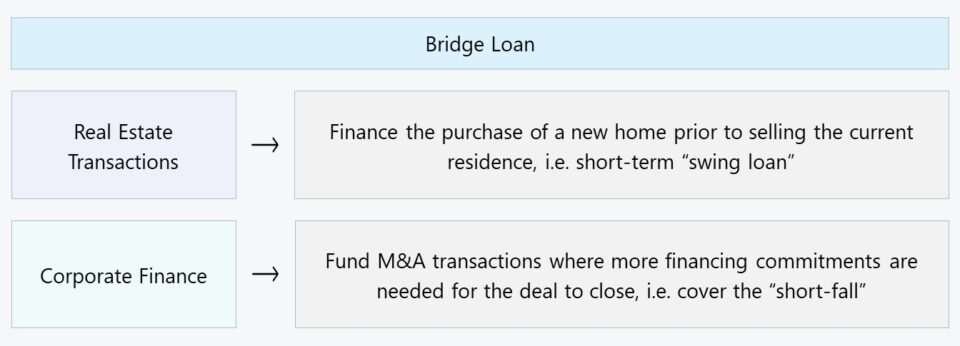What is Bridge Loan?
A Bridge Loan is a source of short-term financing until the borrower secures long-term financing or removes an existing credit facility altogether. The short term bridge loan is backed by collateral, so the lender has the right to seize the underlying pledged asset in the event of default, which is the property financed by the mortgage in the context of real estate financing.

How Does a Bridge Loan Work?
A bridge loan, or “swing loan,” functions as a short-term, temporary financing provided by the lender with the intention to retrieve the funds within six months to a year.
Short-term bridge financing loans are most common in the following two sectors:
- Real Estate Transactions: Bridge loans are a method to finance the purchase of a new home, or similar property, prior to selling the current residence.
- Mergers and Acquisitions (M&A): Bridge loans can be offered in a M&A transaction if the financing commitments needed for the deal to close are temporarily delayed.
In either scenario, the bridge loan is designed to provide near-term funding during a transitionary period.
The bridge loan closes the gap between the date of the new purchase (i.e. transaction close) and the date when permanent financing has been obtained.
Bridge Mortgage Loan Example
Under the context of real estate, bridge loans are utilized when the buyer has insufficient funds to purchase the new property without first selling the property still in their possession – i.e. that is currently on the market.
Typically, these types of short-term instruments are characterized by the following characteristics:
- Secured with Current Home Pledged as Collateral, i.e. Lien on Property
- 6-Month to 1-Year Lending Term
- Same Lender is Often Financing the New Mortgage
- Borrowing Ceiling of ~80% of Original Home’s Value
In effect, the temporary financing commitment offers homebuyers the opportunity to purchase a new house prior to actually selling their current home.
The Wharton Online and Wall Street Prep Real Estate Investing & Analysis Certificate Program
Level up your real estate investing career. Enrollment is open for the Feb. 10 - Apr. 6 Wharton Certificate Program cohort.
Enroll TodayWhat are the Pros and Cons of Bridge Loans?
Bridge Loan Advantages
- Quick, Convenient Source of Financing
- Increased Flexibility, i.e. Bypass Hurdles with Further Delays
- Remove Contingencies and Uncertainties from Other Parties (e.g. the Seller and Sell-Side Advisor)
- Could Directly Result in a Successful Deal, i.e. Higher Probability of Closure
Bridge Loan Disadvantages
- Expensive Fees, i.e. Upfront Charges and Higher Interest Rates
- Risk of Losing Collateral, i.e. Risk of Default and/or Property Foreclosure
- Origination Fees, i.e. “Commitment Fees”
- Short-Term Financing with Penalties, e.g. Funding Fees and Drawn Fees to Incentivize Repayment
- Loan Approval Requires Strong Credit History and Stable Financial Performance
What is the Function of Bridge Loans in M&A?
In M&A, bridge loans serve as an interim financing option used by companies to meet their required total financing needs with a short-term loan.
Similar to their role in real estate financing, these short-term facilities are arranged with the intention of long-term financing from the capital markets to replace it (i.e. “taken out”).
Most often, the provider of the loan comes from an investment bank, or a bulge bracket bank; to be more specific, i.e. the bank has a “balance sheet” rather than purely offering M&A services to its clients.
In the event of a time-sensitive transaction where financing is needed promptly or else the deal might collapse, the investment bank can step in and provide the financing solution to ensure the deal closes (i.e. reduce the uncertainty).
Otherwise, the funding – which can come in the form of debt or equity – is contributed by a venture capital (VC) firm or a specialty lender.
What is the Interest Rate on a Bridge Loan?
The interest rate attached to a bridge loan reflects the credit rating and default risk of the borrower, so there is no “standard” interest rate pricing for bridge loans.
- Interest Rate Pricing → Generally, the interest rates are higher than typical rates under ordinary circumstances.
- Interest Rate “Step-Up” Provision → Further, lenders often place provisions where the interest rate increases periodically across the term of the loan.
Why? The purpose of the lending is for the transaction to close, rather than to earn a high return.
Sellers in M&A deals can require the buyer’s financing commitments to be fully secured, as a condition to proceed further. Buyers frequently turn to investment banks for support in obtaining financing commitments.
Therefore, it is critical to understand that a bridge loan – under the context of an M&A transaction, as well as real estate mortgage financing – is NOT meant to be a long-term source of capital.
In fact, corporate banks aim to avoid bridge loans that remain outstanding for too long. Hence, the inclusion of the conditional provisions to encourage the client to replace such facilities as soon as possible.






